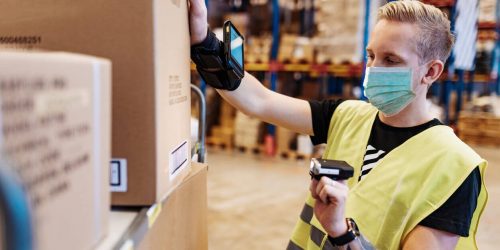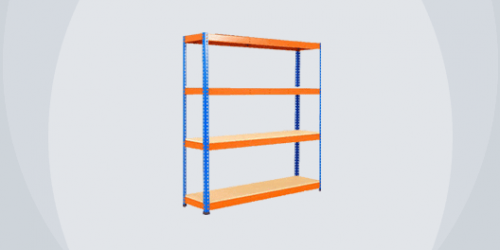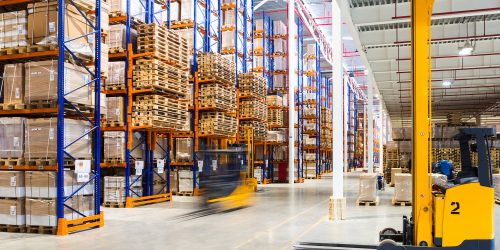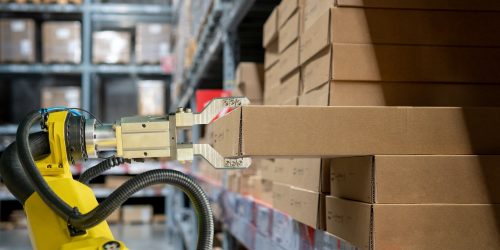How can you improve your warehouse logistics with inventory drones?
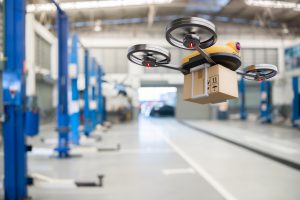
The use of new technologies in warehouses is becoming increasingly widespread and is attracting the attention of many warehouse managers. Saving time and increasing productivity, flexibility, and responsiveness… there are numerous advantages, enabling you to meet ever-growing customer expectations. Among the most widely used technologies, drones are gaining momentum and are contributing to the digital transformation of warehouses as part of logistics 4.0.
Drones driving logistics 4.0
Logistics is one of the sectors that is most likely to embrace the use of drones. Whether for inventory management, warehouse stocktaking, or the delivery of orders, drones have already won over the biggest players in the market.
A drone is a flying robot controlled by remote control. However, certain models can be controlled automatically from a pre-set computer configuration. Models of smart drones are therefore increasingly being developed, particularly for performing repetitive tasks in the warehouse. These smart drones follow a pre-assigned flight path that can be monitored in real-time through a real-time data sharing system.
Inventory drones to manage your warehouse logistics
More and more warehouses are using drones to manage the annual inventory, which involves scanning all products in-stock manually. This is often a demanding task, as it’s resource-intensive and time-consuming. However, there is no real added value in using humans for warehouse inventory management due to the highly repetitive nature of this task. For this reason, some companies have already started to entrust this role to inventory drones, which can check whether products are in stock and detect potential errors.
There are many advantages to using an inventory drone in the warehouse, including:
- Reducing the number of potential human errors;
- Automatic and immediate detection of inconsistencies;
- Reducing inventory costs, as it is not unusual for warehouses to use external resources to carry out this task;
- The concentration of staff on tasks with real added value;
- Relieving staff workload;
- Reducing fatigue and improving operator safety;
- Better traceability of products in stock and changes in stock.
The inventory drone has the potential to be intelligently developed within a warehouse. It is equipped with sensors that enable it to fly without disturbing employees and without hitting the warehouse walls, machinery, or stored products. Furthermore, the drone is often equipped with a reader to capture information from the barcodes or RFID codes of products in stock. More agile and mobile than humans, the inventory drone can scan multiple labels on multiple pallets at the same time. This has the advantage of making it easier to gather information and to obtain the desired product very quickly.
Moreover, the drone is directly connected to the WMS (Warehouse Management System) and can therefore immediately and autonomously communicate the information it has gathered to your warehouse management software.
However, while this may seem like an attractive inventory solution, having a drone in the warehouse can have some drawbacks that are worth taking into account.
First of all, it is vital that products are properly labelled so that the drone can perform its tasks while avoiding malfunctions that would waste your team members’ time.
Secondly, inventory by drone can disrupt some warehouse activities, so it is best to set aside a dedicated area if possible. Otherwise, you should consider operating the drone outside of working hours (e.g. in the evening or during the weekend).
Finally, the drone represents a significant investment, especially if you opt for a model with highly advanced features. There’s a wide range of drones available, but the most useful drones in the warehouse are also the most expensive. Moreover, depending on how you will be using the drone, you will need to plan for additional costs involved in configuring it and optimising its settings. Nevertheless, it is essential to take into account the savings you will make with this equipment. If used correctly, the drone can promise a considerable increase in productivity and responsiveness and free up your staff to focus on much more productive tasks.
Drones for the delivery of orders
Although this practice is much less widespread, it is already being tested in some warehouses, notably at Amazon, UPS, and Google. The delivery of orders by drone consists of delivering the products by air directly to the customer. This solution would make it possible to contain the costs associated with the transport of goods as well as pollution problems.
However, delivery by drone requires certain proximity to the customer and therefore the wider deployment of warehouses in a given area. Moreover, as drones have a limited range, delivery by drone could only be possible in a small and well-defined area.
Finally, legislation around drones is relatively restrictive and does not allow them to move freely in the sky.
Tests are underway in certain warehouses in order to identify delivery solutions that suit consumer expectations and existing constraints.
For more information please visit: www.manutan.co.uk/future-of-work

